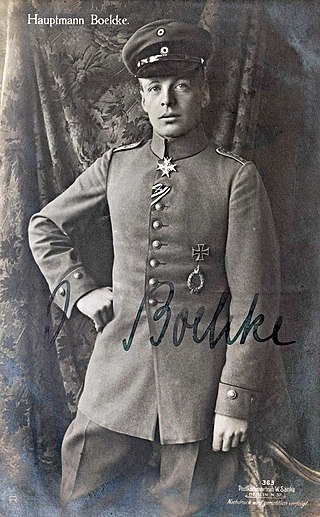
Oswald Boelcke PlM was a World War I German professional soldier and pioneering flying ace credited with 40 aerial victories. Boelcke is honored as the father of the German fighter air force, and of air combat as a whole. He was a highly influential mentor, patrol leader, and tactician in the first years of air combat, 1915 and 1916.

The Dicta Boelcke is a list of fundamental aerial maneuvers of aerial combat formulated by First World War German flying ace Oswald Boelcke. Equipped with one of the first fighter aircraft, Boelcke became Germany's foremost flying ace during 1915 and 1916. Because of his success in aerial combat and analytic mind, he was tasked by Colonel Hermann von der Lieth-Thomsen with writing a pamphlet on aerial tactics.
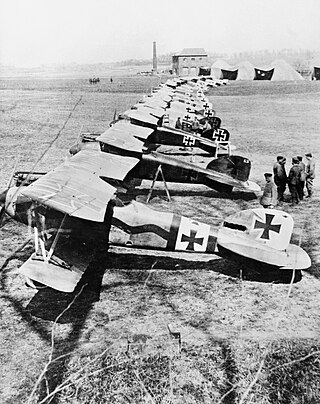
Royal Prussian Jagdstaffel 11 was founded on 28 September 1916 from elements of 4 Armee's Kampfeinsitzerkommandos 1, 2 and 3 and mobilized on 11 October as part of the German Air Service's expansion program, forming permanent specialised fighter squadrons, or "Jastas". It became the most successful fighter squadron in the Luftstreitkräfte.

Erich Loewenhardt was a German soldier and military aviator who fought in the First World War and became a fighter ace credited with 54 confirmed aerial victories. Originally enlisting in an infantry regiment even though he was only 17, he fought in the Battle of Tannenberg, winning a battlefield commission on 2 October 1914. He would serve in the Carpathians and on the Italian Front before being medically discharged in mid-1915. Following a five month recuperation, Loewenhardt joined the Imperial German Air Service in 1916. After serving as an aerial observer and reconnaissance pilot, he underwent advanced training to become a fighter pilot with Jagdstaffel 10 in March 1917. Between 24 March 1917 and 10 August 1918, Loewenhardt shot down 45 enemy airplanes, as well as destroying nine observation balloons. Shortly after his final victory, he was killed in a collision with another German pilot.

Erwin Böhme was a German World War I fighter ace credited with 24 aerial victories. He was born in Holzminden on 28 July 1879. Both studious and athletic, he became a champion swimmer, proficient ice skater, and expert skier, as well as an alpinist. After serving his mandated military service in 1899, and earning a civil engineering degree, he moved to Switzerland for three years of mountaineering.
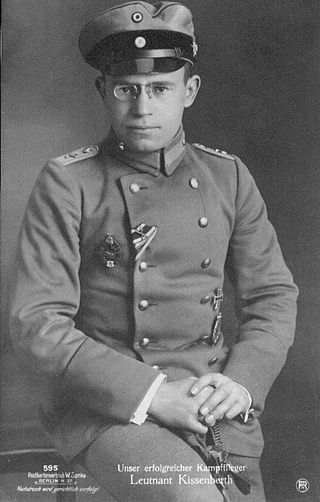
Otto Kissenberth was a German flying ace of World War I credited with 20 aerial victories. He was a prewar mechanical engineer who joined the German air service in 1914. After being trained and after serving as a reconnaissance pilot, he became one of the first German fighter pilots, flying with Kampfeinsitzerkommando KEK Einsisheim. He scored six victories with this unit as it morphed into a fighter squadron, Jagdstaffel 16. His success brought him command of Jagdstaffel 23 on 4 August 1917. He would run his victory tally to 20, downing his final victim using a captured British Sopwith Camel on 20 May 1918. Nine days later, a crash while flying the Camel ended Kissenberth's combat career. His injuries were severe enough he was not returned to combat, instead being assigned to command Schleissheim's flying school. Although Otto Kissenberth survived the war, he died soon after in a mountaineering accident on 2 August 1919.

Max Ritter von Müller PlM, IC, MOMJ was a German World War I fighter ace credited with 36 victories. He was the highest scoring Bavarian pilot of the war.

Heinrich Bongartz PlM, HOH, IC, was a German World War I fighter pilot and flying ace credited with 33 confirmed victories and one unconfirmed. He also served as a night fighter commander in World War II.

A Jagdstaffel was a fighter Staffel (squadron) of the German Imperial Luftstreitkräfte during World War I.

Rittmeister Carl Bolle was a German fighter ace with 36 aerial victories during World War I and a recipient of the Order Pour le Mérite, Prussia's highest award for bravery. He became a Jagdstaffel commander during that war, and an advisor to the Luftwaffe during World War II.
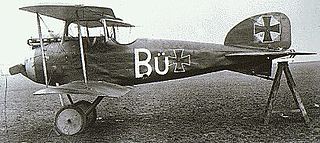
Jasta 2 was one of the best-known German Luftstreitkräfte squadrons in World War I. Its first commanding officer was the great aerial tactician Oswald Boelcke, and it was the incubator of several notable aviation careers.

Emil Thuy, Pour le Merite, Württemberg's Order of Military Merit, House Order of Hohenzollern, Iron Cross First and Second Class, was one of the leading German fighter aces of World War I, with 35 victories. After the war, he was an adviser to the Finnish air force and was involved in the secret origins of the Luftwaffe within the Soviet Union.
Generalmajor Hermann Frommherz Military Order of St. Henry, Royal House Order of Hohenzollern, Knight's Cross of the Military Karl-Friedrich Merit Order, began his military career in World War I as a German ace fighter pilot. He was credited with 32 victories. During World War II he was involved in the German takeover of Czechoslovakia and rose to become a Luftwaffe Generalmajor.

Walter Kuno Reinhold Gustav von Bülow-Bothkamp was a German fighter ace from an aristocratic family who was credited with 28 victories. After entering World War I as a hussar, he transferred to the Imperial German Air Service. He was a recipient of the Pour le Merite, Prussia's highest award for valor, as well as the Knight's Cross of the Military Order of Saint Henry, Saxony's highest award for valor. On 6 January 1918, he was killed in action.

OberleutnantFritz Otto Bernert was a leading German fighter ace of World War I. After being invalided from infantry duty after his fourth wound, Bernert joined the aviation branch. After pilot training, he scored 27 victories between 17 April 1916 and 7 May 1917 despite being essentially one-armed and wearing pince-nez. Among his 15 victories during Bloody April were five scored in 20 minutes on 13 April 1917. He was promoted to squadron command, first of Jagdstaffel 6, then of Jagdstaffel 2. Removed from command on 18 August 1918 by wounds and illness, he died of influenza on 18 October 1918.

Leutnant Otto Paul Wilhelm Höhne was a German World War I flying ace credited with six confirmed aerial victories. Höhne was a pioneer ace; he was the first pilot to score a victory while flying the Albatros D.1. During World War II he was a recipient of the Knight's Cross of the Iron Cross.
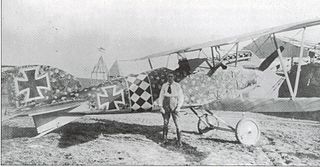
VizefeldwebelFritz John Jacobsen was a German World War I flying ace credited with eight confirmed and two unconfirmed aerial victories.
Royal Prussian Jagdstaffel 1 was a fighter squadron of the Luftstreitkräfte, the air arm of the Imperial German Army during World War I. Jasta 1 was founded on 22 August 1916, using single seat fighters drawn from First Army. It was one of the first wave of dedicated fighter squadrons founded as a result of Oswald Boelcke's espousal of massing fighter air power. Leopold Reimann scored the first of its 138 aerial victories two days later. It served on the Western Front until September 1917, transferred directly to the Italian Front to serve until March 1918, then returned to France for the rest of the war.
Royal Prussian Jagdstaffel 46 was a "hunting group" of the Luftstreitkräfte, the air arm of the Imperial German Army during World War I. As one of the original German fighter squadrons, the unit would score 20 confirmed aerial victories over enemy observation balloons, plus thirty more over enemy aircraft. The Jasta paid a price of ten killed in action, one lost in a flying accident, six wounded in action, and three injured in accidents.


















